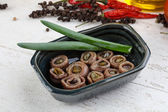A lot of people don't seem to know that they are different from most canned foods which are sterilized by heat. They are preserved by salt or oil that keeps oxygen from them. Had they been pasteurized, they would be like paste in the tin. This is an interesting description from an anchovy manufacturer:
Anchovies are a "semi-preserved" product. This means that they are not sterilized by either cooking or pasteurization. Instead, anchovies are preserved by a salting process whereby salt is used to control bacteria which would otherwise render a canned product unusable.
The anchovies remain in the salt until just before canning. Therefore, suppliers do not pack ahead of order. Our anchovies are not packed until just prior to shipment.
Because they are "semi-preserved", anchovies will eventually break down and become mushy. The cans may even puff. This occurs because there is a non-harmful bacteria that survives in salt. This bacteria can be inconvenient because when it grows it can eventually form a gas which will puff the can. We repeat that this is not harmful to humans, but is most inconvenient.
Heat will hasten the growth of the non-harmful bacteria. Anchovies should always be stored in a cool place, preferably in the refrigerator. Their shelf life when refrigerated is about 18 months. If you do not plan on consuming the anchovies or paste immediately after purchasing, we recommend storing them in the refrigerator. It is important to note that puffed anchovy cans are not indicative of a faulty canning procedure, but rather of improper storage subsequent to canning.
Occasionally, customers complain of a white substance in the can. Often, salt collects around the edges of the fish. This is harmless, as it is only salt.
I thought that might be worth posting as I've seen people wondering why they can't keep anchovy tins on the shelf for years like they would tuna. I've also found that the larger the cans the better the class of anchovy and the better the taste.
We sometimes buy the largest cans and whump up a bunch of anchoiade - here's a recipe:
Persil Anchoiade
100g of anchovies
1 teaspoon or more to taste of capers
2 cloves garlic
4 tablespoons olive oil
1 tablespoon of wine vinegar
1 bunch of parsley
black pepper
Buzz it all up in the processor (or a mortar and pestle if you have one). Make it a little looser for a vegetable dip, or thicker to spread on baguette slices.
A favourite use for us is to make a Pissaladiere - a thin pastry, spread with a heavy layer of the anchoiade, topped with another good thick layer of sauteed caramelized onions dotted with pitted shriveled Nicoise olives and criss crossed anchovies.
Haul out a Cotes du Rhone and find summer bliss.
I also do a reverse version of this where Nicoise olives are the main ingredient (you can use canned black olives but it isn't anywhere near as good - even my wife agrees and doesn't grudge the time it takes to pit the olives to do it right). You call it a tapenade when it is olive based and here is the recipe:
Black Olive Tapenade
1 cup pitted Nicoise olives (Kalamata can substitute)
2 1/2 tbsp capers
a couple of large garlic cloves finely chopped or (better) use a garlic press
6-8 anchovy filets
3 tbsp EVOO
(fresh thyme is optional)
Buzz it until smooth in the processor and use to spread on bread. Keeps a couple of weeks in the fridge. Most people don't even know there are anchovies in it but would miss them if they weren't there.
Don't know what got me thinking about this but now I have an irresistible urge to go open some tins!


